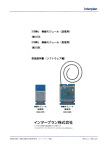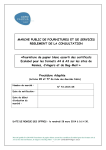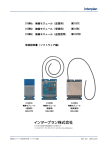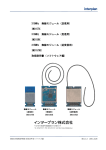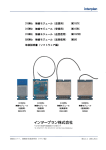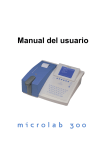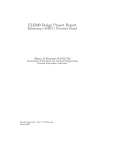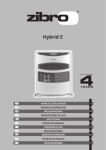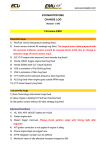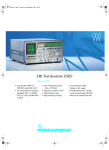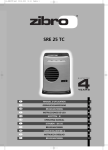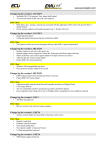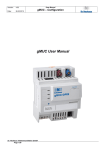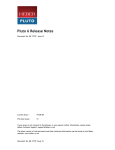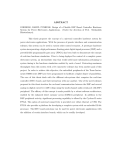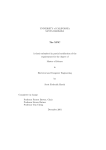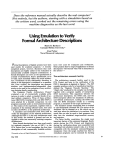Download M32632 V1.0 User`s Manual - cpu
Transcript
M32632_UM_10 M32632 V1.0 User's Manual 17.5.2015 1 Udo Möller M32632_UM_10 Content 17.5.2015 Introduction . . . . . . 3 Files . . . . . . . . 5 Overview . . . . . . . 6 Basic Signals . . . . . 7 General Purpose Interface. . 10 DRAM Interface . . . . . 13 DMA Interface . . . . 19 Coprocessor Interface . . . 21 Interface Timing Behaviour. . 23 Example System . . . . 25 Crossassembler . . . . . 28 2 . Udo Möller M32632_UM_10 Introduction The M32632 is an implementation of the Series 32000 architecture of National Semiconductor. It is 100% software compatible to the NS32532 CPU and NS32381 FPU. The implementation is written in Verilog. The Series 32000 was a 32-bit microprocessor architecture of the 1980's. The basic design concept was CISC : Complex Instruction Set Computer. Similar designs at this time were the Motorola 68030 and the Intel 80386. This user's manual describes the application of the M32632 inside of an FPGA system. If you are interested in details of the Series 32000 architecture, for example the instruction set, please read the datasheets of NS32532 and NS32381. In an FPGA system the CPU is only one component of many other ones. Therefore it is important that the CPU does not consume too much of the resources of an FPGA. The M32632 requires some 15.400 logic elements, 13 18*18 multipliers and 32 memory blocks of 9 Kbits in a Cyclone IV FPGA from Altera. In a -6 speed grade of the same FPGA the M32632 achieves 35 MHz. The table on the next page compares some key characteristics of the original NS32532 and the M32632. 17.5.2015 3 Udo Möller M32632_UM_10 Introduction Feature Clock Frequency Basic Instruction Cycle Count Data Cache Size Data Cache Associativity Instruction Cache Size Instruction Cache Associativity TLB Size TLB Associativity FPU NS32532 M32632 30 MHz max. 35 MHz min. 2 1 1024 bytes 8192 bytes two way two way 512 bytes 8192 bytes direct mapped two way 64 entries 2 * 256 entries fully associative direct mapped NS32381 integrated The clock frequency is for cheap FPGAs. High End FPGAs achive higher clock frequencies. „fully associative“ is better than „two way“ , „two way“ is better than „direct mapped“. 17.5.2015 4 Udo Möller M32632_UM_10 Files Top 1. 2. 3. 4. 5. 6. 7. 8. 9. 10. 11. 12. 13. 14. 15. 16. The M32632 design is spread over 16 Verilog files (ending „.v“). It is preferable to put them in one directory. See the list below for file names and their content. Modules 48 total M32632.v 1 . ICACHE.v 1 . . ICACHE_SM.v 2 . STEUERUNG.v 1 . . DECODER.v 1 . . STEUER_MISC.v 5 . DATENPFAD.v 1 . . I_PFAD.v 7 . . SP_FPU.v 4 . . DP_FPU.v 10 . . REGISTER.v 3 . . ADDR_UNIT.v 1 . DCACHE.v 1 . . CACHE_LOGIK.v 6 . . ALIGNER.v 2 . TOP_MISC.v 2 17.5.2015 2.Level 3.Level 5 Description Top Level of M32632 Instruction Cache Submodules for Instruction Cache Global Control Central Opcode Decoder Submodules for Global Control Data Path Integer Data Path Single Precision FP Data Path Long Operations Data Path Registers of Series 32000 Architec. Address Generator Unit Data Cache Submodules for Data & Instr. Cache Data Aligner Submodules for Top Level Udo Möller M32632_UM_10 Overview Basic Signals Basic Signals DMA IF DMA IF DRAM IF DRAM IF Inputs Outputs Coprocessor IF Coprocessor IF DMA IF General Purpose IF General Purpose IF 17.5.2015 6 Udo Möller M32632_UM_10 Basic Signals Input Signals BCLK „Basic Clock“ of the M32632 and the system. MCLK „Memory Clock“, used for the DRAM interface only, phase locked to BCLK. It is best to use one PLL for generating both clocks. BRESET „Basic Reset“, active low. NMI_N „Nonmaskable Interrupt“, a high-to-low transition of this signal requests a nonmaskable interrupt. INT_N „Interrupt“, a low level on this signal requests a maskable interrupt. WRCFG „Write Configuration“ is a static signal. If it is high, MCLK has to be connected to the inverse of BCLK. If it is low, MCLK is an integer multiple of BCLK. The figure below is a screenshot of the ModelSim simulator and shows the relationship between BCLK and MCLK. The rising edges are phase locked. 17.5.2015 7 Udo Möller M32632_UM_10 Basic Signals Output Signals ILO „Interlocked Operation“, the operations on the bus are interlocked. This is used by the instructions SBITI and CBITI for multiprocessor synchronization. (If someone will use 2 or more CPUs in one FPGA please inform me!) STATSIGS[7:0] „Statistic Signals Bus“, these 8 signals are monitoring bus activity of the M32632. They are active high for one clock cycle for one event. Their meaning is: [0] Data access, internal from the data cache and external [1] Data access from DRAM [2] Data page table entry access [3] Data write to DRAM [4] Program access, internal from the instruction cache and external [5] Program access from DRAM [6] Program page table entry access [7] Collision detected between data write and instruction cache content This signals may be connected to counters to watch M32632 activity. On the next page the output of a program using this feature is presented. Please note that every page table entry (PTE) access includes two data memory reads. Therefore the program corrects the number of data memory reads. 17.5.2015 8 Udo Möller M32632_UM_10 Basic Signals Collisions : 160 Instruction PTE read : 5600 Instruction memory read : 215312 Instruction read : 144370288 Data write : 30620416 Data PTE read : 20048 Data memory read : 4767520 Data read : 54096000 Data Hit-Rate : 91.19 % Instruction Hit-Rate : 99.85 % Elapsed Time : 12.372087 Sek. Statistics of Linpack 100 benchmark on an M32632 system using NetBSD. Output Signals, contd. STATUS[3:0] „Status Bus“, this bus presents a status code for the general purpose interface. Encodings are similar to the NS32532 status signals: 0000 idle 0001 idle, the M32632 is executing a WAIT instruction 0100 Interrupt acknowledge cycle 0110 End of interrupt cycle 1000 Program access cycle 1010 Data access cycle All other codes are currently not used. 17.5.2015 9 Udo Möller M32632_UM_10 General Purpose Interface The general purpose interface is used for any bus operation until ENDRAM becomes active. This is useful after reset when program execution starts at address 0. The first access goes normally to a boot ROM. Later the boot ROM is accessed at a different location in the address space and the DRAM comes in at address 0. This switch over is controlled outside of the M32632. This interface has two limitations: it can not load the caches of the M32632 and is not able to serve MMU operations. But this is not a serious drawback since every FPGA system has a DRAM. Input Signals IO_READY „IO Ready“, the current operation (either a read or write) has finished. This signal is active high. Holding it low will stretch the operation. IO_Q[31:0] „IO Data Read Bus“, the 32 bit wide data bus for any read data. Output Signals IO_RD „IO Read“, if active high it requests a read operation. IO_WR „IO Write“, if active high it requests a write operation. 17.5.2015 10 Udo Möller M32632_UM_10 General Purpose Interface Output Signals, contd. IO_A[31:0] „IO Address Bus“, it contains the 32 bit wide byte address of the data read or written. IO_BE[3:0] „IO Byte Enable Bus“, if active high the corresponding data has to be written. The encoding is as follows: IO_BE[0] Byte 0 = IO_D[7:0] IO_BE[1] Byte 1 = IO_D[15:8] IO_BE[2] Byte 2 = IO_D[23:16] IO_BE[3] Byte 3 = IO_D[31:24] IO_D[31:0] „IO Data Write Bus“, the 32 bit wide bus contains the data to be written. On the next page a simulation run of multiple bus accesses is shown. The instruction executed is a SBITI which activates the ILO signal. This instruction reads one byte, modifies it (set one bit to „1“) and writes back the modified byte. IO_BE[3:0] is set according to the byte address and STATUS[3:0] shows what is ongoing on the general purpose interface. 17.5.2015 11 Udo Möller M32632_UM_10 General Purpose Interface A read access of the general purpose interface can be as short as one clock cycle. But this is not possible if the access is directed to an FPGA memory block. The boot ROM is such a memory block. It needs an extra clock cycle for its internal operation: the address is sent to the memory and on the next rising edge the data is provided to the interface. As far as I know this is true for all FPGAs of all vendors! A write access can always be done in one clock cycle. Program access 17.5.2015 Data Read access 12 Bus idle Write access Program access Udo Möller M32632_UM_10 DRAM Interface The DRAM interface is the most complex interface of the M32632. The reason is the different clocking. For example, on a DE0-nano board from Terasic, the M32632 is clocked with 35 MHz but the DRAM achieves 140 MHz. Transferring signals from one clock domain to another clock domain is always a serious design issue. In the M32632 the data cache and the instruction cache get the high frequency signals from the DRAM controller. This direction is not seriously critical. The other direction needs some special treatment. As already said the rising edges of BCLK and MCLK must be synchronized with a PLL. Any output signal of the M32632 must be synchronized to the falling edge of MCLK inside the DRAM controller first. See the figure: BCLK Flipflop Output Clock-to-output: 200 ps in Cyclone IV MCLK Flipflop Input Setup time: 333 ps in Cyclone IV 3.5 ns window width for an MCLK of 140 MHz Using the rising edge of MCLK is unreliable because of clock jitter! 17.5.2015 13 Udo Möller M32632_UM_10 DRAM Interface Inside the M32632 the rising edge of MCLK is used. Therefore output signals of the DRAM controller must be transfered from falling edge logic to rising edge flipflops. The cache line size of the M32632 is 16 bytes. The cache line is always filled with a burst access of the DRAM. 4 double words (Dword) of 4 bytes each are read without any interruption. The first Dword read is always the one which the M32632 requests. To build an efficient DRAM controller it is important to know the possible Dword sequences from the M32632 point of view: First Dword address: 0 possible next Dword address: 1 1 0 or 2 (!) 2 3 3 2 (or 0 = not critical) The case „first Dword address = 1“ is challenging. A DRAM can be configured to a burst mode of „sequential“ or „interleave“. For the DRAM of the DE0-nano board two column accesses for one burst with mode „interleave“ is the best choice. The write behaviour of the data cache of the M32632 is „write through“. This means that every write data is instantly written to the DRAM. Another method would be „write back“. Only the cache is updated but the external memory is updated later. The advantage of this method (little more performance) is not worth the additional effort (DRAM data not current when DMA occurs). 17.5.2015 14 Udo Möller M32632_UM_10 DRAM Interface The M32632 selects the DRAM in the address space between 0 and 0x0FFF_FFFF (256 MByte). This can be changed on request. Input Signals ENDRAM „Enable DRAM“, if this signal is active high the DRAM can be accessed. DC_MDONE „Data Cache Memory Read Done“, active high if M32632 can proceed (synchronized to BCLK). DC_WCTRL[2:0] [0] [1] [2] ENWR „Data Cache Write Control Bus“: if active high access is not cacheable write pulse for data cache RAM write pulse for first Dword „Enable Write“, active high, goes low if the DRAM interface cannot accept another write request. The M32632 ignores this signal if a write targets the same cache line as the last write (synchronized to BCLK). IC_MDONE „Instruction Cache Memory Read Done“, active high if M32632 can proceed (synchronized to BCLK). IC_WCTRL[2:0] [0] [1] [2] 17.5.2015 „Instruction Cache Write Control Bus“: if active high access is not cacheable write pulse for instruction cache RAM write pulse for first Dword 15 Udo Möller M32632_UM_10 DRAM Interface Input Signals, contd. WAMUX „Write Address Muliplexer“, if this signal is active high it passes the write address to the data cache RAM. WADDR[11:2] „Write Address Bus“, WADDR[3:2] counts the Dword address, WADDR[11:2] is taken either from DRAM_ADR[11:2] or IDRAM_ADR[11:2]. The Dword counter is in the DRAM controller. DRAM_Q[31:0] „DRAM Data Out Bus“, all bits must be valid. Ouput Signals DC_ACC „Data Cache Access“, if active high the data cache is requesting read data. DC_WR „Data Cache Write“, if active high the data cache is requesting a write operation. DRAM_ADR[27:0] [0] [1] [3:2] „Data Cache Address Bus“, used for read and write access: don't care if this signal is active low the access is not cacheable, either suppress DWCTRL[1] or set DWCTRL[0] to active high first Dword to read DRAM_DI[35:0] „DRAM Data In Bus“, the write data to the DRAM: [31:0] Data [35:32] Byte Enable, [35]=[31:24],[34]=[23:16],[33]=[15:8],[32]=[7:0] 17.5.2015 16 Udo Möller M32632_UM_10 DRAM Interface Ouput Signals, contd. IC_ACC „Instruction Cache Access“, if active high the instruction cache is requesting read data. IDRAM_ADR[27:0] [0] [1] [3:2] „Instruction Cache Address Bus“, used only for read access: don't care if this signal is active low the access is not cacheable, either suppress IWCTRL[1] or set IWCTRL[0] to active high first Dword to read Another reason why the DRAM interface is build like this is that in principle the accesses of the data cache and the instruction cache can be overlapped. This is possible because the DRAM has build-in capabilities for two operations in parallel: the row access and the column access. But to build a controller which is able to use this at high frequencies is not an easy task … Please note that IC_MDONE comes one BCLK clock cycle later then DC_MDONE. This is necessary to cover all possible access cases of a program flow. On the next page a simulation output of a read and write operation at the DRAM interface of the M32632 is presented. 17.5.2015 17 Udo Möller DRAM Interface MCLK BCLK M32632_UM_10 Read Access Write Access Please note that the third Dword (WADDR = 0a2) is written one clock cycle of MCLK before the rising edge of BCLK. This is necessary for the memory block of the cache RAM to read the correct next data (either from 0a0 or 0a2). The first write is not critical because the data is read inside the M32632 from a register. The write access requires one clock cycle of BCLK. The signal ENWR goes inactive on the falling edge of BCLK eventually delaying the next write access. One of two buffers is now written to the DRAM. If this is done ENWR goes active again. 17.5.2015 18 Udo Möller M32632_UM_10 DMA Interface The NS32532 is able to continue its internal operations even if a HOLD request is ongoing. The M32632 does not have this feature. If HOLD becomes active, it stops internal operations and signals its hold status via HLDA to a DMA controller. The reason for this behaviour is the large cache. It is not acceptable to invalidate the whole cache when a DMA request modifies the DRAM content (therefore a DMA read from DRAM is not critical). This invalidation has to be done in the NS32532 by software via the CINV instruction. However this instruction is not optimal. It can only invalidate a cache line (16 byte) or the whole cache. The M32632 uses the same behaviour for CINV. In addition it implements a cache snoop function in hardware to realize cache coherency. Input Signals HOLD „Hold“, if this signal is active low it request bus free for another agent. FILLRAM „Fill RAM“, if this signal is active high an invalidate request for the cache line address on DMA_AA is executed. DMA_AA[27:4] „DMA Address Bus“, address to be checked by the caches. Output Signals HLDA 17.5.2015 „Hold Acknowledge“, this signal is active low when the M32632 has stopped any activity. 19 Udo Möller M32632_UM_10 DMA Interface The signal FILLRAM can be active every second clock cycle. DMA_AA must be valid during FILLRAM and the following clock cycle. The figure below shows a simulation run with five invalidate requests at highest speed. one invalidate request 17.5.2015 20 Udo Möller M32632_UM_10 Coprocessor Interface The coprocessor capability of the Series 32000 is used by National Semiconductor itself. The NS32381 FPU is an external coprocessor. Therefore instructions using this coprocessor have a lot of communication overhead. In contrast the M32632 has the floating point unit integrated and avoids the communication overhead. The result is much faster operation. Nevertheless it is useful to add the external coprocessor capability also to the M32632. It provides an easy way to expand the functionality of the CPU. Not everybody will like the idea of manipulating the core itself. The M32632 V1.0 is able to execute the CCV0, CCAL0, CCAL1, CCAL2, CCAL3, CMOV0, CMOV1 and CMOV2 custom instructions. Input Signals COP_DONE „Coprocessor Done“, if this signal is active high for one clock cycle it signals the completion of the requested operation. COP_IN[63:0] „Coprocessor Data Input Bus“, this bus is connected to the data output port of the coprocessor. A quad word is transfered over bits [63:0], a double word over bits [63:32], a word over bits [47:32] and a byte over bits [39:32]. 17.5.2015 21 Udo Möller M32632_UM_10 Coprocessor Interface Output Signals COP_GO „Coprocessor Go“, if this signal is active high the coprocessor starts the requested operation. COP_OP[23:0] „Coprocessor Opcode Bus“, this bus contains the three opcode bytes. Please look at the datasheet of the NS32532 for details of the instruction formats. COP_OUT[127:0] „Coprocessor Data Output Bus“, this bus is connected to the data input port of the coprocessor. It can hold two 64 bit quad word operands and is static throughout the coprocessor operation. The location of data depends on the operation: Bits 127...96-95....64-63....32-31.....0 One Double Word XxXxXxXx_B3B2B1B0_XxXxXxXx_XxXxXxXx One Quad Word XxXxXxXx_B7B6B5B4_XxXxXxXx_B3B2B1B0 Two Double Words XxXxXxXx_B3B2B1B0_XxXxXxXx_b3b2b1b0 Two Quad Words B7B6B5B4_B3B2B1B0_b7b6b5b4_b3b2b1b0 Bi = first operand, bi = second operand, Bi/bi = byte i 17.5.2015 22 Udo Möller M32632_UM_10 Interface Timing Behaviour The timing of an input signal is not critical if it feeds directly the data input of a flipflop. The timing of an output signal is not critical if it comes directly from the output of a flipflop. This chapter describes the timing characteristic of each input and output signal. D Q critical Logic D Q Logic D Q not critical D Q Inputs D Q critical Outputs not critical M32632 17.5.2015 23 Udo Möller M32632_UM_10 Interface Timing Behaviour Input Signals Not relevant: BCLK, MCLK, WRCFG Not critical: BRESET, NMI_N, INT_N, IO_READY, IO_Q[31:0], HOLD Weakly critical, should be driven by output of flipflop: IC_MDONE, DC_MDONE, ENWR, ENDRAM, FILLRAM, DMA_AA[27:2] Strongly critical, must be driven by output of flipflop: IC_WCTRL[2:0], DC_WCTRL[2:0], WAMUX, WADDR[11:2], DRAM_Q[31:0], COP_DONE, COP_IN[63:0] Output Signals Not critical: STATSIGS[7:0], IC_ACC, IDRAM_ADR[27:0], DC_WR, DC_ACC, DRAM_ADR[27:0], DRAM_DI[35:0], IO_RD, IO_WR, IO_A[31:0], IO_BE[3:0], IO_DI[31:0], COP_GO, COP_OP[23:0] Weakly critical, should not feed deep logic trees: STATUS[3:0], ILO, HLDA, COP_OUT[127:0] 17.5.2015 24 Udo Möller M32632_UM_10 Example System An example system using the M32632 is available for starters. It allows simulation, synthesis and can be used to configure a real system. Most users will start with a development system for FPGAs. Adopting the example to a certain development system is an easy task. The 8 bit input port is connected to some switches and the 8 bit output port is connected to some LEDs. The program of the example transfers data from the input port to the output port. 17.5.2015 Coprocessor General Purpose IF Boot ROM Statistic Counters 25 DRAM Emulator IO Bus Controller M32632 Switches Input Register LEDs Output Register The figure below shows the block diagram of the example system. example.v Udo Möller M32632_UM_10 Example System The following files are used for the example system: 1. example.v 2. example_mods.v 3. example_tb.v 4. example.sdc the top module for synthesis containg the M32632 the submodules of the example system the test bench for simulating the example system the timing requirements file The file example.sdc definies the timing for the example system. The most important definition is for the clock cycle time. Current setting for the clock signal is 30 ns with the falling edge at 15 ns. This setting should be pass for every modern FPGA. The file example.qsf is used by Altera's Quartus software to setup a project. Each system using the M32632 contains at least two other functional blocks: the IO bus controller and the boot ROM. The „IO Bus Controller“ does the following: 1. selects different locations for writing based on their addresses 2. multiplexes the incoming data busses for the M32632 Please note : there is no tri-state bus inside a FPGA! 3. manages the switch over between boot ROM and DRAM 4. generates IO_READY and a clean reset A boot ROM is a memory which stores the first instructions after reset for a CPU. The other blocks are optional: 1. DRAM Emulator: almost every development board has a standard DRAM on it. But there are many standards: SDRAM, DDR, DDR2, … To avoid building a DRAM controller a DRAM emulator is provided for a quick start. 17.5.2015 26 Udo Möller M32632_UM_10 Example System The DRAM emulator uses internal memory blocks of the FPGA. The example implements 16 kBytes. If your FPGA has enough capacity the memory can be enlarged. But 16 kBytes should be sufficient even for some experiments with virtual memory. 2. Coprocessor: as an example the coprocessor implements a byte swap instruction. In a double word or a quad word the byte order is reversed. 3. Statistic Counters: these counters are connected to the STATSIGS[7:0] bus of the M32632. In this way, the CPU can monitor its own activity. If there are only LEDs available showing this information may be difficult. A small LCD display is a better choice. 4. Input Port: the input port is connected to any switches on the development board. If there are more than 8 switches one can read a word instead of a byte from the port. A two stage synchronizer is provided to avoid any metastability inside the FPGA system. 5. Output Port: the output port is connected to any LEDs on the development board. As with the input port its width depends on the number of LEDs. A nice application for starters is a measurement system for reaction times. One of multiple LEDs is activated and a certain button or switch must be pressed. The time between these events is measured and displayed. Another application is a clock based on an interrupt every second. If this is boring for you, develop a DRAM controller for your board ... 17.5.2015 27 Udo Möller M32632_UM_10 Crossassembler The crossassembler „ans32k“ is used on a Windows PC to generate assembler programs for the M32632. The output can be used in simulation, configuration and in real systems. The syntax is similar to other assembly languages. Another way of generating programs is to use the gnu tool chain. It provides crossassembling and crosscompiling. But you have to use old versions of gnu which still support Series 32000! „ans32k“ is used in a command shell: C:\ … \ans32k filename <outfile> <-list> <-code> <-mif> <-n> Arguments and options (<...>) are: filename the name of the input file. <outfile> other name for the output file, must be the 2. argument. Default is „boot_rom.txt“, for -mif it is „bootcode.mif“. <-list> this option generates a list file containing the address of each instruction. The name of the file is „filename.LST“. <-code> this option adds the binary code of the instruction to the list file. <-mif> change the output format to Altera mif format instead of simple hex. <-n> size of the target ROM, valid values for n are 1,2,4 and 8 kBytes. Default is 1 kBytes. Datawidth is always 32 bit. 17.5.2015 28 Udo Möller




























